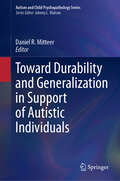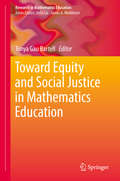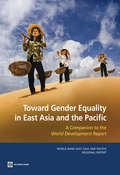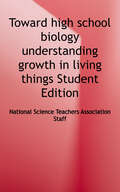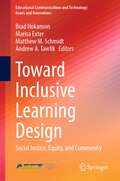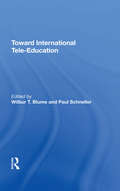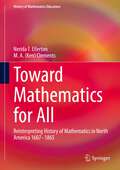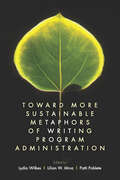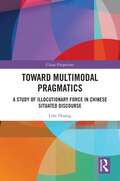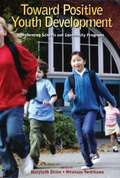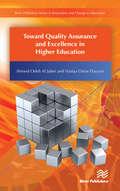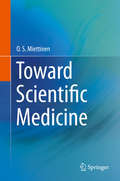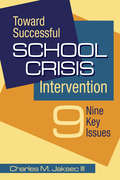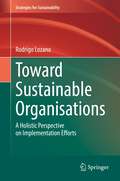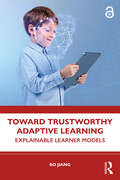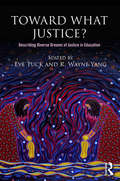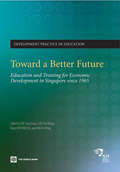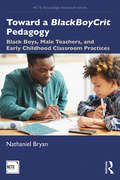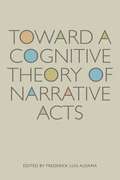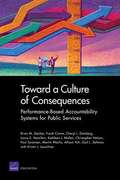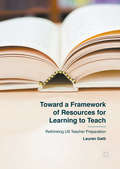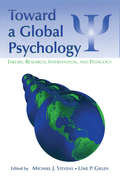- Table View
- List View
Toward Durability and Generalization in Support of Autistic Individuals (Autism and Child Psychopathology Series)
by Daniel R. MitteerThis book describes methods for improving the maintenance and generalization of behavior analytic treatment outcomes for individuals with autism. It introduces the concept of durability—not just treatments that maintain across days or weeks, or that generalize to a few new settings, but those that remain successful under increasingly challenging situations (e.g., over years, during changing reinforcement conditions, across service providers). Chapters address key topics, such as preventive care, early behavioral intervention, treatment of severe destructive behavior, teaching skills across the lifespan, and medication management. In addition, the book addresses ethical and cultural considerations as they relate to treatment maintenance and concludes with perspectives from autistic voices and caregivers. Chapters include case examples highlighting durable outcomes as well as schematics and materials (e.g., data sheets) to assess and maintain treatment gains. Key areas of coverage include: Behavioral persistence, durability of treatment effects, and relapse across the following domains. Early learner and academic skills. Toileting and self-care skills, feeding behavior, and verbal behavior. Social skills and socially reinforced destructive behavior. Automatically reinforced destructive behavior. Medical compliance, implementer behavior, and geriatric behavior.
Toward Equity and Social Justice in Mathematics Education (Research In Mathematics Education Ser.)
by Tonya Gau BartellThis critical volume responds to the enduring challenge in mathematics education of addressing the needs of marginalized students in school mathematics, and stems from the 2015 Annual Meeting of the North American Group of the Psychology of Mathematics Education (PME-NA). This timely analysis brings greater clarity and support to such challenges by narrowing in on four foci: theoretical and political perspectives toward equity and justice in mathematics education, identifying and connecting to family and community funds of knowledge, student learning and engagement in preK-12 mathematics classrooms, and supporting teachers in addressing the needs of marginalized learners. Each of these areas examines how race, class, culture, power, justice and mathematics teaching and learning intersect in mathematics education to sustain or disrupt inequities, and include contributions from scholars writing about mathematics education in diverse contexts. Included in the coverage: Disrupting policies and reforms to address the needs of marginalized learnersA socio-spatial framework for urban mathematics educationLinking literature on allywork to the work of mathematics teacher educatorsTransnational families’ mathematical funds of knowledgeMultilingual and technological contexts for supporting learners’ mathematical discoursePreservice teachers’ strategies for teaching mathematics with English learners Toward Equity and Social Justice in Mathematics Education is of significant interest to mathematics teacher educators and mathematics education researchers currently addressing the needs of marginalized students in school mathematics. It is also relevant to teachers of related disciplines, administrators, and instructional designers interested in pushing our thinking and work toward equity and justice in mathematics education.
Toward Freedom and Dignity: The Humanities and the Idea of Humanity
by O. B. Hardison Jr.Originally published in 1973. Toward Freedom and Dignity is a humanist's view of the humanities in an age of burgeoning technology. O. B. Hardison Jr. deals with the status of the humanities and their future—how they are regarded and how they may come to contribute to a genuinely humane society. He argues that humanistic studies are not a luxury in either education or society. They are central to the preparation of human beings for the kind of society that is possible if we manage to avoid an Orwellian technocracy. Social goals and priorities must be set in terms of the ideal of a culture truly adjusted to human needs and human limitations. In framing his argument, Hardison draws on ideas of the humanities since the Renaissance, especially on the philosophical humanities that emerged in Europe in the works of authors like Kant, Schiller, and Coleridge. He is untroubled by anti-humanistic trends in college curricula and the surrounding culture, and he contends that we have only one practical option: to ensure that culture evolves toward a more humane society, toward freedom and dignity.
Toward Gender Equality in East Asia and the Pacific: Companion to the World Development Report
by The World BankToward Gender Equality in East Asia and the Pacific examines the relationship between gender equality and development and outlines an agenda for public action to promote more effective and inclusive development in East Asian and Pacific countries. Written as a companion to the World Development Report 2012 on gender equality and development, the report finds that promoting gender equality contributes to higher productivity, income growth, and poverty reduction; improves the opportunities and outcomes for the next generation; and enhances the quality of development policymaking. It contributes to the understanding of gender and development policymaking in several important ways. First, the report presents new data and evidence that significantly strengthen the empirical basis for policymaking on gender and development in the region. Second, the report provides new analysis of the gender dimensions and policy implications of several global trends that are particularly important in the region, including increasing economic integration, rapid adoption of new information and communication technologies, rising domestic and international migration flows, rapid urbanization, and population aging.
Toward High School Biology: Understanding Growth in Living Things
by National Science Teachers Association StaffThrough 19 carefully sequenced lessons and activities, this unit gets middle schoolers ready for next-level learning. Students explore what happens at the molecular level so they can understand how living things grow and repair their body structures. Using Legos, ball-and-stick models, videos, and print manipulatives helps them retain what they learn so they can apply that knowledge later. <p><p>Both effective and engaging, Toward High School Biology Draws on a research-based development approach. Multiple cycles of design and revision based on results from classroom field tests, feedback from teachers, expert scientific input, and criteria-based evaluations ensure the high quality of the unit. Takes an interdisciplinary approach. Lessons focus on phenomena related to chemical reactions that take place in both physical and life science contexts, from the rusting of a metal bicycle to the production of muscles in humans. Supports the Next Generation Science Standards. All three dimensions of science learning science and engineering practices, disciplinary core ideas, and crosscutting concepts are carefully integrated in each chapter. It is refreshingly easy to use. <p><p>The Student Edition should be used in conjunction with the Teacher Edition, which provides complete lesson plans and instructions for carrying out the activities. Complementary video demonstrations and tutorials are available online. <p><p>Toward High School Biology, Student Edition provides the materials you need to guide your students through these investigations. With lesson details, teacher facilitation pages, and handouts, your students will be ready to start investigating.
Toward Inclusive Learning Design: Social Justice, Equity, and Community (Educational Communications and Technology: Issues and Innovations)
by Brad Hokanson Andrew A. Tawfik Marisa Exter Matthew M. SchmidtThis book examines how society has been affected by the social upheaval of the years since George Floyd’s death and efforts by those in education and educational technology to address the concerns of equity, community and social justice. This book is a practical yet scholarly guide in the pursuit of inclusive design, drawing from a diverse range of authors with a broad range of application and theory. The chapters go beyond a narrow view of inclusive learning design, and address issues in a broad range of fields. This book is appropriate for all levels of learning, with a distinct focus on higher education and graduate education.
Toward Independence: The Use of Instructional Objective in Teaching Daily Living Skills to the Blind
by Anne YeadonThis book is an introduction to the use of instructional objectives in the teaching of severely visually impaired persons. While it happens to use a daily living skills course as an example of how a teacher might develop a course around this educational method, it is not a daily living skills teaching manual. A creative teacher should be able to adapt the approach as described in Toward Independence to many other subjects.
Toward International Tele-Education
by Wilbur BlumeIn the spring of 1983, concerned representatives from the communication technology, education, and government sectors gathered at a conference to explore possibilities for tele-education. This book presents their views and provides a wealth of information bearing on past, present, and future tele-education efforts. The authors in Part 1 describe gl
Toward Mathematics for All: Reinterpreting History of Mathematics in North America 1607-1865 (History of Mathematics Education)
by Nerida Ellerton M. A. ClementsThis book presents a history of mathematic between 1607 and 1865 in that part of mainland North America which is north of Mexico but excludes the present-day Canada and Alaska. Unlike most other histories of mathematics now available, the emphasis is on the gradual emergence of "mathematics for all" programs and associated changes in thinking which drove this emergence. The book takes account of changing ideas about intended, implemented and attained mathematics curricula for learners of all ages. It also pays attention to the mathematics itself, and to how it was taught and learned.
Toward More Sustainable Metaphors of Writing Program Administration
by Lydia Wilkes Lilian W. Mina Patti PobleteThe field of writing program administration has long been a space rich in metaphor. From plate-twirling to fire-extinguishing, parents to dungeon masters, and much more, the work of a WPA extends to horizons unknown. Responding to the constraints of austerity, Toward More Sustainable Metaphors of Writing Program Administration offers new lenses for established WPAs and provides aspiring and early career WPAs with a sense of the range of responsibilities and opportunities in their academic and professional spaces. This volume presents twelve chapters that reclaim and revise established metaphors; offer new metaphors based on sustainable, relational, or emotional labor practices and phenomena; and reveal the improvisational, artisanal nature of WPA work. Chapters resonate across three sections. The first section focuses on organic relationships captured in phrases like “putting out fires” and "seeing forests for the trees” alongside unexpected comparisons to ground and light. The second describes institutional landscapes featuring generative juxtapositions such as the WPA as a labor activist or a mapper of emotional geography. And the third discusses performance crafts like improv comedy and artisanal making. Toward More Sustainable Metaphors of Writing Program Administration offers new and revised ways of thinking and acting for WPAs, who are constantly negotiating the paradoxical demands of their work and continually striving to act ethically in conflicted, and even fraught, situations. It will inspire practicing, aspiring, and former WPAs working in a time of transformation by highlighting more sustainable ways of enacting WPA identity. Contributors: Jacob Babb, John Belk, Katherine Daily O'Meara, Ryan J. Dippre, Douglas Hesse, Andrew Hollinger, Rona Kaufman, Cynthia D. Mwenja, Manny Piña, Scott Rogers, Robyn Tasaka, Alexis Teagarden, Christy I. Wenger, Lydia Wilkes
Toward Multimodal Pragmatics: A Study of Illocutionary Force in Chinese Situated Discourse (China Perspectives)
by Lihe HuangClassic pragmatic theories emphasize the linguistic aspect of illocutionary acts and forces. However, as multimodality has gained importance and popularity, multimodal pragmatics has quickly become a frontier of pragmatic studies. This book adds to this new research trend by offering a perspective of situated discourse in the Chinese context. Using the multimodal corpus approach, this study examines how speakers use multiple devices to perform illocutionary acts and express illocutionary forces. Not only does the author use qualitative analysis to study the types, characteristics, and emergence patterns of illocutionary forces, he also performs a quantitative, corpus-based analysis of the interaction of illocutionary forces, emotions, prosody, and gestures. The results show that illocutionary forces are multimodal in nature while meaning in discourse is created through an interplay of an array of modalities. Students and scholars of pragmatics, corpus linguistics, and Chinese linguistics will benefit from this title.
Toward New Horizons for Women in Distance Education: International Perspectives (Routledge Library Editions: Education and Gender #9)
by Karlene FaithOriginally published in 1988. This book provides an overview of women’s experience, access and needs in distance education. It includes contributions on distance learning programmes in Holland, Canada, the South Pacific, West Germany, Australia, New Zealand, Israel, Kenta, Great Britain, India, Papua New Guinea, Sweden and Turkey. Within this diversity are common international themes on the nature of the educational process for women in distance learning, whether the subject is building construction or art teaching. The incorporation of a historical perspective and an evaluation of the prospects for the future contextualises the descriptions of the ways in which women are currently re-defining themselves through distance education around the world.
Toward Positive Youth Development: Transforming Schools and Community Programs
by Marybeth Shinn Hirokazu YoshikawaThis book shows how to harness the power of settings. It shifts the debate from simply enhancing youth outcomes at the individual level to improving the settings of youths' daily lives. The book offers researchers and practitioners blueprints for creating and changing influential settings including classrooms, schools, universities, out-of-school time programs, ethnic systems of supplementary education, and other community-based programs. Leading scholars in psychology, education, human development, sociology, anthropology, economics, law, and public policy discuss a wide array of social change strategies, and describe how to measure key features of settings as a target and guide for change. The authors also demonstrate how larger social structures - such as school districts, community coalitions, community data resources - can support change. Many of the chapters describe ways to make settings work for all youth, including those marginalized by reason of race, ethnicity, social class, or sexual orientation. Toward Positive Youth Development will guide researchers, educators, administrators and policy makers to improve schools and youth programs for all of America's youth.
Toward Quality Assurance and Excellence in Higher Education (River Publishers Series In Innovation And Change In Education - Cross-cultural Perspective Ser.)
by Ahmed Odeh Al JaberQuality Assurance is not a new concept in the education sector in general, and higher education in particular, though it is becoming increasingly more relevant and important. Higher education helps to improve an individual's quality of life by enabling them to inflate their knowledge and expertise, to grasp abstract concepts and theories, and to raise their awareness of the world and their community, and as such the assurance of quality is becoming more pivotal in the whole education process.There is no simple definition of the concept of quality in education, though numerous models and theories have been devised. Toward Quality Assurance and Excellence of Higher Education is a new episode of the Quality Assurance perception in higher education, which identifies the quality culture and orientation from the beginning, integrating crucial factors to build a “pyramid” of higher education excellence. The book compares concepts from the main theories of Quality Assurance, management and control when they are applied to educational systems in higher education. The book also presents a new model of excellence in higher education. Excellence is an architecture of building blocks that comes with process performance, effectiveness, harmony and collaboration which should be incorporated in a quality-oriented concept of a sustainable excellence of higher education. The model integrates four main facets: the Educational System, Quality Assurance Managing and Control, Strategic Planning and Globalization. Also presented are international “best-practices” in quality assurance in higher education, from Japan and Finland.
Toward Scientific Medicine
by O. S. MiettinenScientific medicine in Miettinen's conception of it is very different from the two ideas about it that come to eminence in the 20th century. To him, medicine is scientific to the extent that it has a rational theoretical framework and a knowledge-base from medical science. He delineates the nature of that theoretical framework and of the research to develop the requisite knowledge for application in such a framework. The knowledge ultimately needed is about diagnostic, etiognostic, and prognostic probabilities, and it necessarily is to be codified in the form of probability functions, embedded in practice-guiding expert systems. In these terms, today's medicine still is mostly pre-scientific, and major innovations are needed within and around medicine for healthcare to get to be in tune with reasonable expectations about it in this Information Age. Thus, while the leading cause of litigation for medical malpractice in the U. S. is failure to expeditiously and correctly diagnose the probability of myocardial infarction in a hospital's emergency room, this book shows that a typical modern textbook of cardiology, just as one of medicine at large, imparts no knowledge about the diagnostic probabilities needed in this, and that the prevailing type of diagnostic research will not produce the requisite knowledge. If the diagnostic pursuits in an ER would be guided by an emergency-room diagnostic expert system, this would guarantee expert diagnoses by all ER doctors. Academic leaders of medicine and medical researchers concerned to advance the knowledge-base of medicine will find a wealth of stimulus for thinking about the deficiencies of the prevailing knowledge culture in and surrounding medicine, and about the directions of the needed progress toward genuinely scientific medicine.
Toward Successful School Crisis Intervention: 9 Key Issues
by Charles M. JaksecPrompts crisis intervention team members to reevaluate their beliefs and practices, and offers illustrative vignettes, helpful tips, and discussion questions to guide reflection and action.
Toward Sustainable Organisations: A Holistic Perspective on Implementation Efforts (Strategies for Sustainability)
by Rodrigo LozanoThe book is one of the first ones focussing on how organisations (civil society, corporations, and public sector ones) are contributing to sustainability. The book starts by providing a discussion of the four dimensions of sustainability (economic, environmental, social, and time). The second chapter focusses on what organisations are, their system elements (e.g. operations and production, management and strategy, and governance), stakeholders, relationships within and between organisations (ranging from competition to collaboration), and a framework for organisations to understand and map how they can contribute to sustainability. The third chapter discusses the twenty-four main tools, initiatives, and approaches (TIAs) that have been developed for organisations to contribute to sustainability, such as Circular Economy, Corporate Social Responsibility, Environmental Management Systems, and Sustainability Reporting. The fourth chapter focusses on organisational change management for sustainability, including types of change, drivers for change, resistance to change, incorporation, and institutionalisation. The fifth chapter presents empirical evidence on what civil society organisations have contributed to sustainability, from priorities and impacts, TIAs, external stimuli, and internal factors, drivers for change, starts of change, and development of change. The sixth chapter presents empirical evidence on what corporations have contributed to sustainability, from priorities and impacts, TIAs, external stimuli, and internal factors, drivers for change, starts of change, and development of change. The seventh chapter presents empirical evidence on what public sector organisations have contributed to sustainability, from priorities and impacts, TIAs, external stimuli, and internal factors, drivers for change, starts of change, and development of change. The last chapter provides the conclusions of the book.The book is aimed at providing a multi-level, dynamic, and holistic perspective on the contributions of organisations to sustainability. The book's uniqueness lies in analysing organisations’ efforts to become more sustainability oriented and contribute to making societies more sustainable through systems thinking, TIAs, and change processes.
Toward Trustworthy Adaptive Learning: Explainable Learner Models (Assessment of Educational Technology)
by Bo JiangThis book offers an in-depth exploration of explainable learner models, presenting theoretical foundations and practical applications in the context of educational AI. It aims to provide readers with a comprehensive understanding of how these models can enhance adaptive learning systems.Chapters cover a wide range of topics, including the development and optimization of explainable learner models, the integration of these models into adaptive learning systems, and their implications for educational equity. It also discusses the latest advancements in AI explainability techniques, such as pre-hoc and post-hoc explainability, and their application in intelligent tutoring systems. Lastly, the book provides practical examples and case studies to illustrate how explainable learner models can be implemented in real-world educational settings.This book is an essential resource for researchers, educators, and practitioners interested in the intersection of AI and education. It offers valuable insights for those looking to integrate explainable AI into their educational practices, as well as for policymakers focused on promoting equitable and transparent learning environments.
Toward What Justice?: Describing Diverse Dreams of Justice in Education
by Eve Tuck K. Wayne YangToward What Justice? brings together compelling ideas from a wide range of intellectual traditions in education to discuss corresponding and sometimes competing definitions of justice. Leading scholars articulate new ideas and challenge entrenched views of what justice means when considered from the perspectives of diverse communities. Their chapters, written boldly and pressing directly into the difficult and even strained questions of justice, reflect on the contingencies and incongruences at work when considering what justice wants and requires. At its heart, Toward What Justice? is a book about justice projects, and the incommensurable investments that social justice projects can make. It is a must-have volume for scholars and students working at the intersection of education and Indigenous studies, critical disability studies, climate change research, queer studies, and more.
Toward a Better Future: Education and Training for Economic Development in Singapore since 1965
by Sing Kong Lee'Toward a Better Future' provides a comprehensive analysis of education development in Singapore since 1965, giving particular attention to the strategic management that has enabled Singapore to transform its education and training system from one similar to that of many Sub-Saharan African countries four decades ago into one of the world's best-performing systems. It is one of a pair of concurrently-published books presenting materials originally developed for a 2006 study tour to Singapore and Vietnam for senior education officials from Cameroon, Ethiopia, Ghana, Lesotho, Madagascar, and Mozambique. The second book, 'An African Exploration of the East Asian Education Experience', presents five country studies, as well as regional, comparative analyses highlighting insights gained during the study tour and putting them in the context of Sub-Saharan Africa. Together, the two books aim to foster knowledge exchange between Sub-Saharan African and East Asian countries on good practices in the design and implementation of education policies and programs. By facilitating the cross-country fertilization of ideas between two regions with relatively limited contact in the past, these books fi ll a clear gap in the current literature on development practice in education.
Toward a BlackBoyCrit Pedagogy: Black Boys, Male Teachers, and Early Childhood Classroom Practices (NCTE-Routledge Research Series #1)
by Nathaniel BryanCritical and necessary, this book provides a window into the education and lives of Black boys in early childhood settings. Drawing on Black Critical Theory and Black Male Studies, and applying portraiture methodology, Bryan explores experiences of Black boys and their male teachers in ways that affirm their humanity and acknowledge the consequences of existing in a white supremacist system. Bryan’s nuanced and comprehensive portraits honor the voices of Black boys and their male teachers, and counter the one-dimensional and essentialist perspectives that proliferate in our schools, which Bryan identifies as anti-Black misandry. Introducing BlackBoyCrit Pedagogy, Bryan addresses the impact of socially constructed stereotypes and perceptions in the classroom and highlights the importance of educators who challenge such practices. In so doing, he provides a much-needed in-depth examination of pedagogies, literacies, and practices Black male teachers employ, as well as a perceptive view of the academic and social landscapes Black boys must navigate.
Toward a Cognitive Theory of Narrative Acts
by Frederick Luis AldamaToward a Cognitive Theory of Narrative Acts brings together in one volume cutting-edge research that turns to recent findings in cognitive and neurobiological sciences, psychology, linguistics, philosophy, and evolutionary biology, among other disciplines, to explore and understand more deeply various cultural phenomena, including art, music, literature, and film. The essays fulfilling this task for the general reader as well as the specialist are written by renowned authors H. Porter Abbott, Patrick Colm Hogan, Suzanne Keen, Herbert Lindenberger, Lisa Zunshine, Katja Mellman, Lalita Pandit Hogan, Klarina Priborkin, Javier Gutiérrez-Rexach, Ellen Spolsky, and Richard Walsh. Among the works analyzed are plays by Samuel Beckett, novels by Maxine Hong Kingston, music compositions by Igor Stravinsky, art by Jean-Baptiste-Simeon Chardin, and films by Michael Haneke. Each of the essays shows in a systematic, clear, and precise way how music, art, literature, and film work in and of themselves and also how they are interconnected. Finally, while each of the essays is unique in style and methodological approach, together they show the way toward a unified knowledge of artistic creativity.
Toward a Culture of Consequences
by Brian M. Stecher Frank Camm Cheryl L. Damberg Laura S. Hamilton Kathleen J. MullenPerformance-based accountability systems (PBASs) link incentives to measured performance to improve services to the public. Research suggests that PBASs influence provider behaviors, but little is known about PBAS effectiveness at achieving performance goals. This study examines nine PBASs that are drawn from five sectors: child care, education, health care, public health emergency preparedness, and transportation.
Toward a Framework of Resources for Learning to Teach
by Lauren GattiThis bookadvances a new framework for learning to teach, using in-depth case studies toshow how learning to teach--in any type of program--can best be understood as arecursive and dynamic process, wherein teachers differentially accessprogrammatic, relational, experiential, disciplinary, and dispositionalresources. In the lasttwenty years, debates in the field of teacher preparation have increasinglybecome paralyzing and divisive as rhetoric around the failure of universityteacher preparation intensifies. The author addresses the historical andpractical factors that animate these debates, arguing that novice teachers andteacher educators must understand the central conflicts in the field; however,the book also advances a way of approaching learning to teach that accounts forbut does not get stuck at the level of programmatic designation. Using lively,in-depth case studies, the author shows how novice urban English teachers fromtwo different teacher preparation pathways--a university-based program and an urbanteacher residency--learn to teach within a policy context of high-stakes testingand "college readiness. "
Toward a Global Psychology: Theory, Research, Intervention, and Pedagogy (Global And Cross-cultural Psychology Ser.)
by Uwe P. Gielen Michael J. StevensToward a Global Psychology defines the emerging field of international psychology. It provides an overview of the conceptual models, research methodologies, interventions, and pedagogical approaches that are most appropriate to transnational settings. In so doing, the book provides readers with a rich appreciation of how to approach a global psycho
